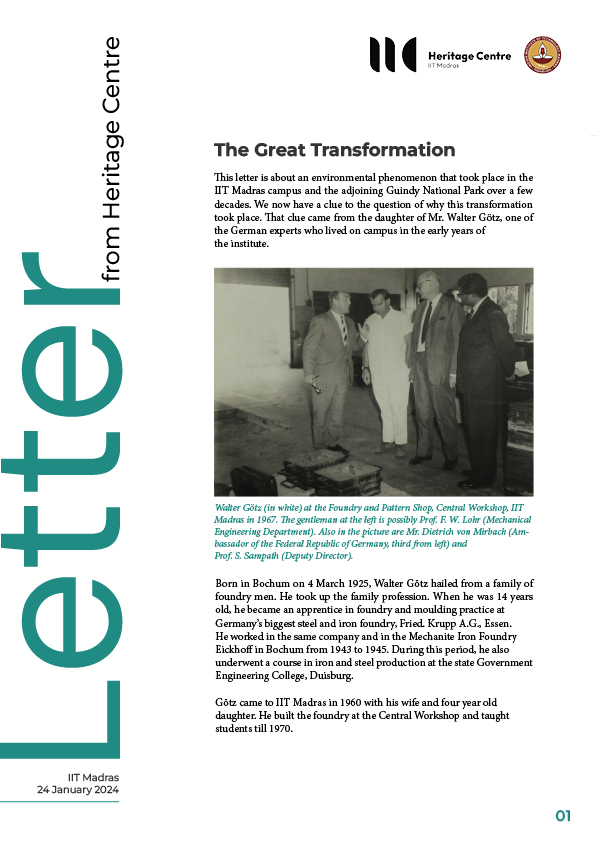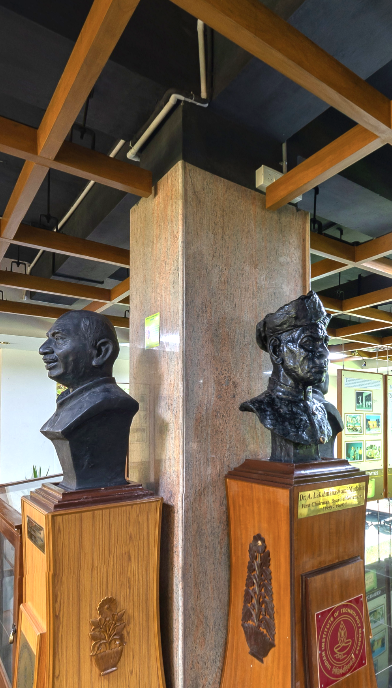
-
Letter from Heritage Centre - March 2024
Mar 05, 2024
Kumaran Sathasivam
Following the Life of Prof. Sengupto

Prof. A. Ramachandran (second from left) taking over as Director of IIT Madras from Prof. B. Sengupto (right), c. 1967. At left is Mr. Sethunathan, second Registrar of the institute. Seen behind Prof. Sengupto is Prof. S. Sampath.
For a long time, we did not have much information at the Heritage Centre on the life of Prof. B. Sengupto, the first Director of IIT Madras.
From the material at hand, we knew that his tenure as Director of IIT Madras had been from 1959 to 1967. We knew that the ‘B.’ in Prof. Sengupto’s name stood for ‘Bibhutibhushan’. We also knew that he was born on 14 September 1903. He had had ‘an illustrious career not only as a professor of mechanical engineering but also as an industrial engineer and technical education manager in our country for about half-a-century’. At the institute’s 16th convocation, held in 1979, Prof. Sengupto received a degree—the degree of Doctor of Science, Honoris Causa—and these details are in the citation. The citation also says that Prof. Sengupto had had a brilliant scholastic record in his early years consisting of a string of first-class first-rank successes, culminating in ‘the winning of the coveted Prince of Wales Gold Medal of the Benares Hindu University in 1926’.We had heard that Prof. Sengupto had been the head of the Victoria Jubilee Technical Institute (renamed Veermata Jijabai Technological Institute subsequently), VJTI for short, at Bombay, before he came to Madras. And we had heard that his wife was Mrs. Shanti Sengupto.
But beyond these details, if you can call them that, we knew nothing. Where had Prof. Sengupto been born, for instance? Where had he had his education? Where did he live after his retirement?
A photograph showing Prof. Sengupto (first from left, back row) as a young man with his family. Mrs. Shanti Sengupto is in the middle in the back row. Photo received from Devaki Bhaya
More information came our way from a brief biography of Prof. Sengupto provided by Mr. Mallik Putcha, of the first batch of students of IIT Madras. The biography had been drafted by Mr. Jawahar Niyogi, a relative of Prof. Sengupto. Mr. Niyogi was, incidentally, also an alumnus from an early batch. We learnt that Prof. Sengupto had been born in East Bengal (the year of his birth, according to this bio, was 1905). After his early education in East Bengal and Calcutta, he had ‘studied at the Benares Hindu University, one of the foremost universities of the
day, known for its engineering studies. Thereafter he went to England and did further studies at Manchester.
Devaki Bhaya, Director Sengupto’s niece, assisting with the building of IIT Madras, c. 1965. Photo received from Devaki Bhaya
Mr. Jawahar Niyogi visited the Heritage Centre in early 2020, along with Prof. Sengupto’s niece, Dr. Devaki Bhaya, who gave us a fine set of photographs of Prof. and Mrs. Sengupto and their families. These included a series of three pictures showing Dr. Devaki at the IIT campus in 1965, as a small girl. She was ‘helping’ construction workers,
and Prof. Sengupto paid her Rs.5 for her efforts to ‘build the institution’!

Prof. Sengupto’s name (‘Mr. B. Sengupta’) in the 46th annual report of VJTI, Bombay; the table used by Prof. Sengupto at VJTI as the Principal, now in Director Dhiren Patel’s office
Since VJTI was where Prof. Sengupto had spent the better part of his career, I was keen to check if I could find information about him there. I got an opportunity to visit VJTI in 2021. I was able to browse through some of their annual reports, thanks to enthusiastic facilitation by Director Dhiren Patel, Prof. Faruk Kazi and Prof. Rohin
Daruwala and their colleagues. I saw that Prof. Sengupto had been the Deputy Head of the Mechanical Engineering Department in the year 1930–1931 (his name was written as ‘Mr. B. Sengupta’). The 1935–1936 annual report indicated that his academic qualification was ‘B.Sc. (Eng. Benares)’, and in the staff list of the 1937–1938 report showed that he also had an ‘A.M.I. Mech. E’.
Prof. Dhiren Patel told me that his table was the one that had served Prof. Sengupto when he was the Principal of VJTI, back in the 1950s. Thanks to a roster of Principals and Directors displayed prominently at VJTI, I knew the years Prof. Sengupto had been Principal: 1956–1959. Thus my visit to VJTI proved to be rewarding in the quest to trace Prof. Sengupto’s life.
Prof. Sengupto in the list of heads of VJTI

Prof. Sengupto at IIT Madras in 1970 Source: Campastimes, September 1970.
After his retirement, according to Mr. Niyogi’s bio, Prof. Sengupto lived in a bungalow he built by the Ganges at Bandel (a metaphorical stone’s throw from Calcutta). We know Prof. Sengupto visited IIT Madras at least a few times after his retirement:
• An article in Campastimes (the September 1970 issue, to be specific) tells us that Prof. Sengupto visited IIT Madras once in May 1970.
• From a stone tablet at the IIT Madras swimming pool, we know of another visit of his a few years later—it was Prof. Sengupto who inaugurated the pool in 1976.
• And of course, he came to received Doctor of Science, Honoris Causa, in 1979.
Prof. Sengupto passed away in 1983.Kumaran Sathasivam
Views
The Great Transformation (Letter from Heritage Centre, 24 January 2024)

Prof. Susy Varughese: We should superimpose [Chennai rainfall data] to get better analysis. Especially the excess rains in recent years have contributed significantly to this increase in green cover. I remember the late eighties, used to have so much water scarcity. The surplus water that is coming to the city also contributes in many ways to these changes.
Dr. Ajith Kumar (NCBS): I think the removal of cattle, better “protection”, and perhaps even some afforestation were the reasons. It will be good to write about this, with supporting imageries.
Dr. V. Santharam (Rishi Valley Institute of Bird Studies & Natural History):Prosopis invasion maybe! Over a period of time, trees grow and the canopy spreads.Your response to Letter from Heritage Centre is welcome.
Please send mail to heritage@iitm.ac.in.
The Heritage Centre is located in the ground floor of the
Administration Building, IIT Madras.
It is open on weekdays from 9.30 am to 7.00 pm
heritage.iitm.ac.inYour response to Letter from Heritage Centre is welcome. Please send mail to heritage@iitm.ac.in
The Heritage Centre is located in the ground floor of the Administration Building, IIT Madras. It is open on weekdays from 9.30 am to 5.30 pm.
- Contribute
to the Centre -
Monetary
Support - Digital
Material









